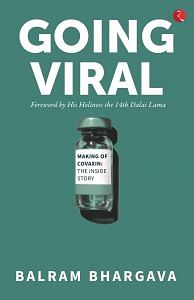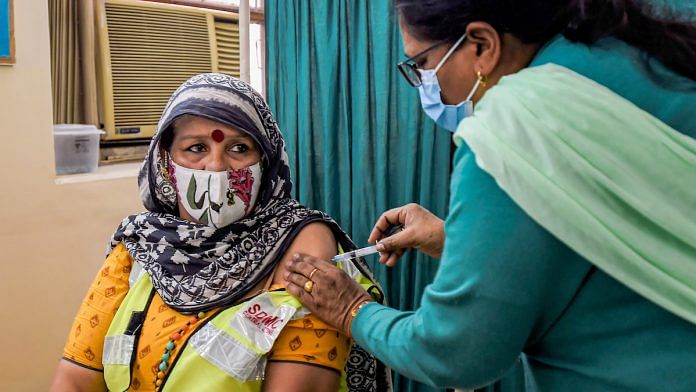Imagine having to solve a complicated jigsaw puzzle where the pieces are all in different rooms and on different floors, the stairs are broken and you must find your way around blindfolded, and then put the pieces together as fast as possible before the whole house falls down. If this sounds difficult, just imagine trying to understand, isolate and work out how to treat a mysterious virus during an international lockdown.
Researchers typically came to work early in the morning and went home very late—if they managed to go home at all. At the ICMR headquarters in New Delhi too, key staff members often worked till 2.00 a.m., which also meant long hours for everyone else, from security guards to those running the cafeteria. Virtual boardroom meetings at the oddest hours became the norm. To further complicate logistics, the national lockdown affected everything. Guesthouses were full of scientists, most of whom were women, who had the added worry of families at home to think about. On the one hand, home with older parents and young children; on the other, a high-security lab with a deadly virus to contain.
The research got a boost, particularly since there was already a system in place in an organization that is more than 111 years old. This is a system in which thinking is very scientific from the very beginning and there is some sense of hierarchy. This was very good, and could be leveraged at that point in time, particularly in the warlike situation of the pandemic. I think it worked best for India. It was our work culture which helped us tremendously during those hours of crisis.
Scientific arguments were always welcome and encouraged, but at the same time, there was a sense of discipline, which really led to achieving what we have—whether it be my video conferencing with all the directors, the directors with their scientists and the scientists with their technical officers. It was woven together exceptionally, whether it be the different institutes working together, different labs working together or scientists working together—for the larger good of the country.
Also read: UK adds Covaxin, China’s Sinovac to approved vaccine list for travellers
While everyone involved made terrific sacrifices and risked their own safety to work during a pandemic, women, whether they were scientists, transport personnel, bureaucrats, health workers or whatever else, had the added burden of facing the challenges of COVID-19 as well as managing households, children who were home, elder care and transportation to and from work in uncertain times. With all that, they shone, and retained their enthusiasm for the job, and for science. ‘75 per cent of my team were women,’ Dr Priya Abraham proudly stated. Women were indeed the real superheroes of the entire effort.
Dr Abraham is the perfect role model for young people, especially young women, to get excited about careers in science. If she weren’t so busy managing a passionate team
of scientists and saving the world from COVID-19, she could be a wonderful STEM brand ambassador.
I had to deal with all kinds of people at every level: within the institutes, within ICMR, within the scientific agencies of the country, other public health agencies or medical colleges and even the press and the bureaucracy. We had a list of about 570 different treatments which had been proposed by people. This included one involving a locket with a stone in it that produced chlorine. We faced enormous pressure. There were people who had their own companies and wanted to do certain things which were not working that well or wanted to know whether their ideas were working. But we knew we had to put our scientific resources in the targeted direction, remain undistracted from these unproven, non-scientific cures.
Also read: Covid a ‘very pretty virus’ — ICMR DG Balram Bhargava recollects early pandemic days in India
Repurposing Infrastructure
During the pandemic, the strengths and capacities at all the ICMR institutes and other facilities were pooled together to get the best possible outputs. Repurposing helped us
manage many things. The staff was engaged in a series of activities like serosurveys, follow-up of vaccine rollouts, testing, validation of diagnostic commodities, creating depots for storage, distribution of commodities, coordination with states, etc. It wasn’t business as usual, as we pivoted from our routine ongoing work and research to various institutes,
labs and outreach units to deal with an unprecedented new situation. We leveraged our capacities holistically and it definitely paid off!
During the pandemic, the ICMR institutes also perfected the art of multitasking. This has again hugely benefited the entire system and helped the ICMR family fight the pandemic in unison. The serosurvey was done by all the different institutes, whether it be the nutrition institute or the regional medical research centre in Gorakhpur or a cancer centre or a tuberculosis institute. They all got into the Covid framework of mind. And they were all involved in fighting Covid in every which way, whether it be data collection, serum sample collection, testing or development and distribution of testing kits or even small animal studies.
One example of such innovations was the setting up of a high-throughput laboratory at our institute in Noida. We had a building with a defunct incinerator in the animal house of the institute. In April 2020, the incinerator was removed and the whole building was repurposed as a high-throughput laboratory, with more than 12 RT-PCR machines, having a capacity of up to 4,000 tests per day. Initially, samples were flown in here from different parts of the country to be tested rapidly. Technology played a great role. Today, we have labs in nearly every district of India, and that is reassuring.
Another big step forward was strengthening our field epidemiological capacities. India has been a torchbearer in conducting repeated nationwide sero-surveys for SARS-CoV-2. These field epidemiological capacities are expected to be repurposed for several other important
studies, particularly to determine the burden of vaccine-preventable diseases and assess post-vaccination trends.
Also read: Covaxin, Covishield effectiveness highest when gap between doses is 6-8 weeks, ICMR study finds
Nurturing the country’s laboratory infrastructure has been another important outcome, from a long-term health systems perspective. We all felt the need to establish molecular diagnostic capacities for detecting infectious disease pathogens. ‘Earlier we had only a few labs in the country that had the people and facilities to diagnose and study viral disease outbreaks. But now there is a good quality lab in virtually every district of India,’ Dr Samiran Panda, head, ICMR’s Epidemiology and Communicable Diseases Division said.
This is a tremendous value addition to India’s public health system. We are determined to effectively repurpose our infrastructure and human capital (read: all the dedicated people involved in this work and future scientists) for other infectious diseases like tuberculosis, respiratory viral infections including influenza and other emerging/re-emerging infections and zoonotic infections. The backbone of health infrastructure in the country
has been a socialistic public health-, medical college- and district hospital-based infrastructure. We have the same system for research. These can all be renovated. They can be repaired. They can be repurposed for COVID-19, as we have done for the ICMR institutes and demonstrated how we repaired our infrastructure, not only during the pandemic but before the pandemic also. The repurpose can be done for testing, research, patient care, etc. We wrote down the ideas as they occurred to us. Even simple things, like better toilet facilities in hospitals, tackling the stray menace in hospital premises, wall posters falling off, etc., were noted down.
Covid gave us an opportunity to revisit these issues and fix them. In the long term, as I have mentioned earlier, we need to spend more on healthcare. There are countries such as the US which spend 20 per cent of their $20 trillion budget on healthcare. We’ve been spending only one per cent, although that is being increased now. We are targeting healthcare spending to 2.5 per cent of the GDP and the government is moving in this direction rapidly.
A cardiologist by training, Professor Balram Bhargava is currently the Director General of the Indian Council of Medical Research (ICMR).
 This excerpt from ‘Going Viral, Making of Covaxin: The Inside Story’ by Prof (Dr) Balram Bhargava has been published with permission from Rupa Publications.
This excerpt from ‘Going Viral, Making of Covaxin: The Inside Story’ by Prof (Dr) Balram Bhargava has been published with permission from Rupa Publications.



